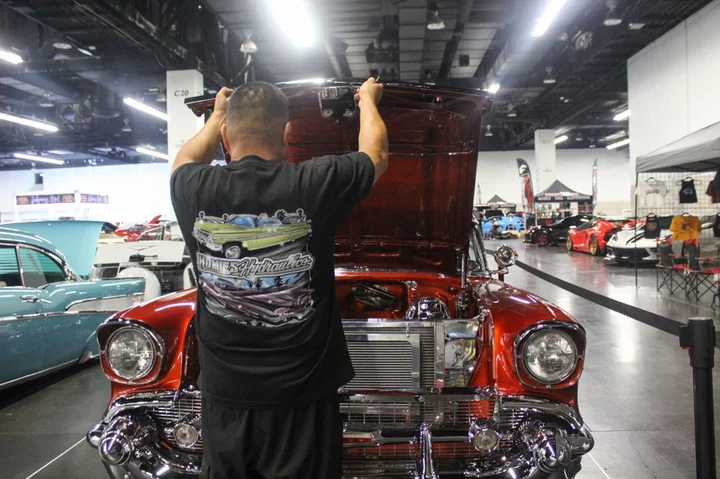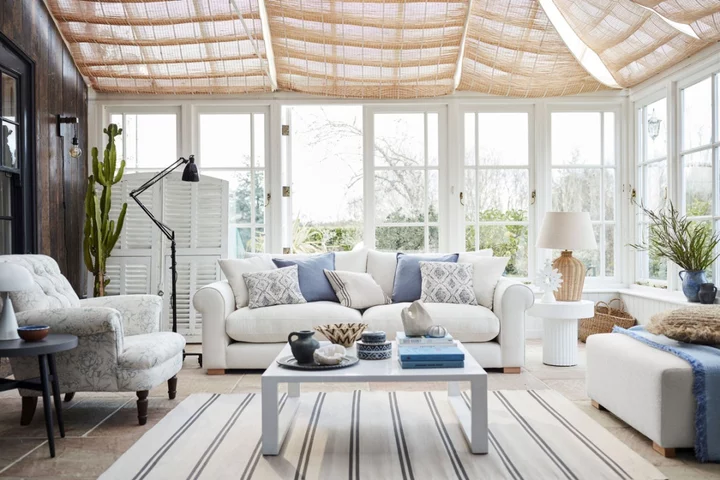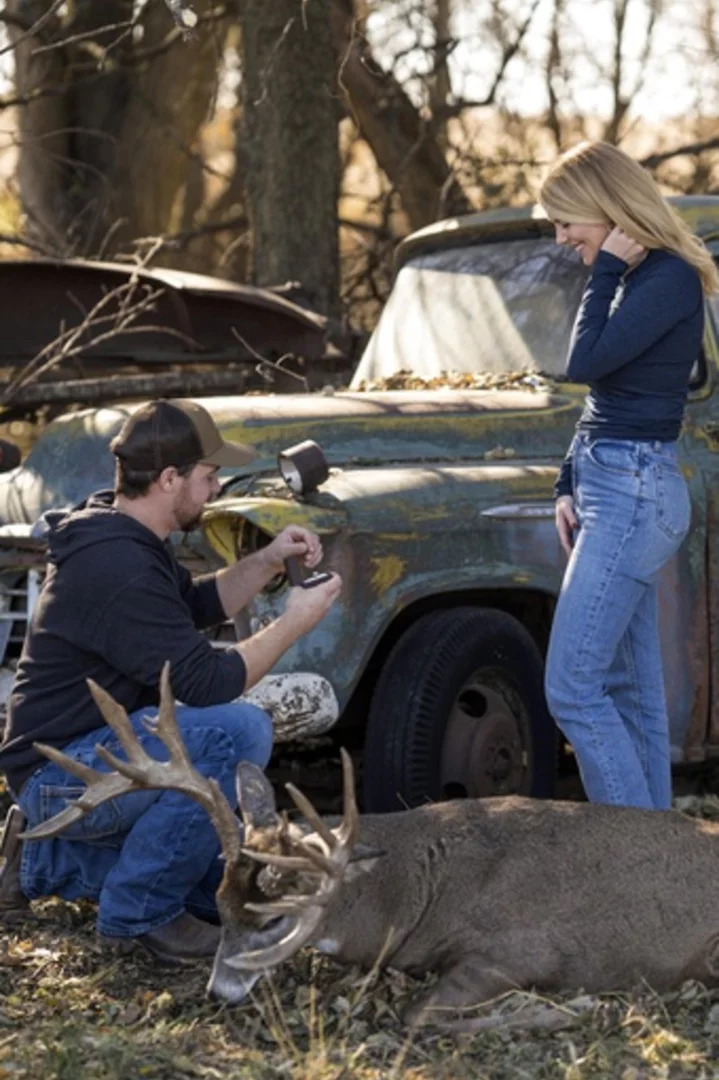Following a family of four, I shuffle into the Anaheim Convention Center for The Takeover, an annual car show displaying and celebrating the sickest lowriders in California. Like me, hundreds of people gather around more than 1,000 souped-up and tricked-out vehicles. We all marvel at the street opulence.
In my view, there’s an emerald green 1959 Chevrolet Impala called Krypto9 as well as a gold-trimmed 1950s Schwinn bicycle with a deep-red, velvet seat. But the show-stopper is undoubtedly Life After Death, a 1962 Chevrolet Impala — convertible, to boot. It’s a luxurious sight. On the exterior, the lowrider’s delicate chrome and gold plating sparkles against the car’s rich, olive-green varnish. With the vehicle’s light-brown drop-top open, I can also see the lights wired inside illuminating the engravings. There’s matching gold plating on the panel of each door, along the seats, around the windows, and throughout the dashboard. And, of course, “Life After Death” is embroidered on the floor mats.
“A lot of people will tell you that lowriding is a lifestyle [and not a luxury].”
ernesto perezThe lavish vehicle is a labor of love between Ernesto Perez and Sarai Quintero, who have invested approximately $250,000 and countless hours into this car. Still, neither of them considers the expensive wheels a luxury. In the 20 years they’ve been lowriders — a Chicane subculture built around customized cars that use hydraulic jacks to bring the vehicle closer to the road, aka as low as possible — investing in cars has always been, and will always be, a lifestyle.
“A lot of people will tell you that lowriding is a lifestyle [and not a luxury] because we plan our weekend, our life, around lowriding. We’ll go cruising or work on our car all day and night,” Perez tells Refinery29 Somos, adding that all his time off is spent on his wheels. “I don’t go to Hawaii and go to the beach. This is my vacation. I think we spend more time traveling to shows than going on vacations. I haven’t been on a vacation for over 10 years.”
According to Denise Sandoval, PhD, a professor of Chicana and Chicano Studies at California State University, Nothridge who has studied lowrider culture for more than 25 years, to position lowriding as a luxury is borderline dismissive. “People talk about lowriding as a way of life, so it doesn’t fit into luxury. It doesn’t fit into just a hobby,” Sandoval tells Somos. In her work, she’s also found that lowrider culture centers families, with cars and insider knowledge passed down from generation to generation.
“But can’t lowriding be both? Can’t it be a luxurious way of life? And don’t we, Chicanes, deserve to claim our lujos as such?”
Natalie Arroyo CamachoFor instance, Angel Romero, president and jefa at Dueñas Car Club — an all-women car club based in Northern California — inherited her 1965 Chevrolet Impala (dubbed Saturday Love) from her mom, who was a solo rider in the ‘70s. “It’s the lifestyle. It’s how I was raised. This is my culture. I know nothing besides being a woman in lowriding,” Romero tells Somos. “For me, everything is lowriding. All my weekends are lowriding. All my vacation days are lowriding. Most of my shopping consists of car parts.”
Many of the lowriders I spoke with agree that the culture is a lifestyle, not a luxury. But can’t lowriding be both? Can’t it be a luxurious way of life? And don’t we, Chicanes, deserve to claim our lujos as such?
A brief history of Chicane car culture
According to Smithsonian magazine, the history of lowriding dates back to 1940s Los Angeles. At the time, car culture was growing across the country. On the West Coast, Mexican American veterans were able to afford purchasing cars with the income they were earning from their service in World War II; meanwhile, they were able to customize their new vehicles as a result of the mechanical training they had received in the military.
Three decades later, the hobby turned political with the rise of the Chicano movement. In response to escalating anti-Mexican xenophobia and racism, lowriders expressed and celebrated their identities by incorporating traditional Mexican imagery, like flowers and mythic figures, on their vehicles. Even more, some car clubs held fundraisers for movements and organizations like the United Farm Workers labor union.
“Lowriders expressed and celebrated their identities by incorporating traditional Mexican imagery, like flowers and mythic figures, on their vehicles.”
NATALIE ARROYO CAMACHOHowever, because most lowriders were Chicane, outsiders often stereotyped them as criminals.
“They say that [lowriders] are gangsters; that we’re drug dealers or low-life people who have nothing else to do,” Alejandro “Chino” Vega, the owner of CL Customs, an automotive customization shop in the San Fernando Valley, tells Somos. But as a 40-year lowriding veteran, Vega says that’s never been the culture’s ethos. Instead, he says, lowriders tend to cruise the streets safely and put on events for their community. It’s camaraderie, not criminal activity, that guarantees them respect. And Vega would know. In the short time I’m with him, a dozen people waved, gave a nod, or down-right stopped him in his tracks to say hello.
Lowriding is a lifestyle and a luxury
Luxury, as defined by Cambridge Dictionary, is “great comfort, especially as provided by expensive and beautiful things.” We often conceptualize grandeur as a lavish vacation, designer jewelry, and maybe even a Birkin bag. But lowriders are also “expensive and beautiful things” that provide comfort, joy, and even respect to their drivers.
Even more, luxury consumption scholar Yajin Wang argues that “high-tech cars and bicycles” also comprise luxury. In fact, among the most luxurious of vehicles is undoubtedly the Rolls Royce, and in 2020, the automobile maker partnered with lowriders from the Greater Los Angeles Area for a photo series exhibition called “King of the Night.” The campaign, which promoted the manufacturer’s Black Badge Cullinan, demonstrated that lowriders fit right in with one of the most luxurious vehicles in the world.
And like with Rolls-Royces, Maseratis, and Lamborghinis, highly customized lowriders are not affordable to all, or even most, in the community. Not everyone has the expendable income to invest in lowriding — and the people who don’t have the money see the lifestyle as a luxury.
“It’s definitely a luxury to be able to own an old-school car.”
Angel Romero“It’s definitely a luxury to be able to own an old-school car,” says Romero, who has invested upwards of $30,000 in her ‘65 Impala and plans to put more money into it as she wants to own more than one lowrider. Even Perez, the man behind “Life After Death,” refers to his wheels as his own “Louis Vuitton.”
As a child of Mexican immigrants, it feels important to name our luxuries as such. For so long, I, and so many others, have struggled to self-indulge. We may have witnessed our loved ones or our community face financial insecurity and feel guilty for enjoying a costly hobby or lavish lifestyle. Or we may have only seen luxury portrayed to us in an individualistic and capitalist manner that feels different from the community at the center of lowrider culture. But we do deserve luxury and, despite the historically negative perceptions around lowriding, we must recognize and appreciate it as well-deserved Chicane splendor.
To be sure, even the little lowriders recognize it as such. At The Takeover, 11-year-old Jay Madrid tells me he plans to get his first lowrider when he’s 30 or 40 years old. “I’m going to get a 1954 Chevy Impala and paint it a rare color,” he says. But why two or three decades from now and not the second he gets his driver’s license? “It would be impossible. You have to at least work some years for the money to put into these cars.”









